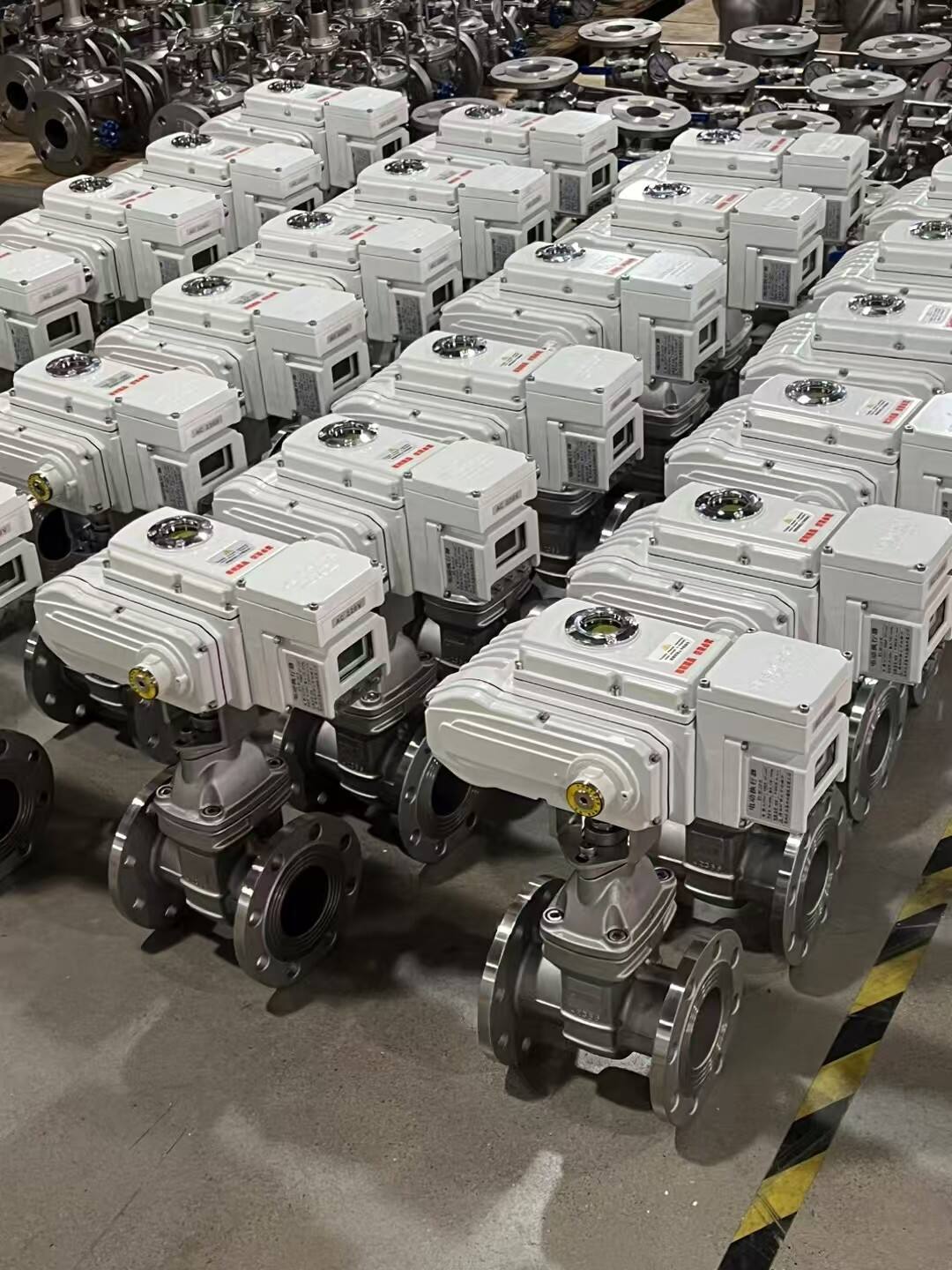Precision Flow Control for Sensitive Chemical Processes
Why precise flow regulation is critical in chemical manufacturing
The chemical manufacturing industry needs flow accuracy within about half a percent to keep reactions on track and avoid expensive batch failures according to the Chemical Processing Journal from last year. When there's more than 2% variation in how much catalyst gets added, product purity drops around 40%. And if cooling systems aren't properly controlled, they create up to 70% more unwanted byproducts. These days, trying to manage valves manually just doesn't work for plants dealing with dangerous materials such as nitroglycerin or ethylene oxide. Most operators have moved away from this approach entirely because even small mistakes can lead to major problems down the line.
How electric actuators enable accurate and repeatable valve positioning
Electric actuators achieve 0.25° positioning resolution using brushless DC motors and 16-bit encoder feedback, outperforming pneumatic systems by 300% in step-response consistency. This enables:
- Repeatable dosing – 99.8% consistency across 10,000 cycles in API production
- Micro-flow regulation – 5 mL/min precision in additive injection
- Position memory – Automatic compensation for seat wear over 50,000 actuations
A 2023 material compatibility study found PTFE-coated actuators generate less than 0.1 μm of particulates, making them ideal for ultra-pure chemical transfer.
Case Study: Electric ball valves ensuring dosage accuracy in a pharmaceutical plant
| Parameter | Pneumatic Valve | Electric Valve | Improvement |
|---|---|---|---|
| Dosage Error Rate | 2.8% | 0.12% | 23x |
| Maintenance Intervals | 3 months | 18 months | 6x |
| Energy Consumption | 85 kWh/month | 22 kWh/month | 74% – |
| Leakage Incidents | 9/year | 0/year | 100% – |
A pharmaceutical manufacturer achieved 99.98% batch consistency after replacing 142 pneumatic valves with ISO 15848-certified electric ball valves on their oncology drug line.
Integrating electric valves with PID controllers for optimal process stability
Closed-loop electric valve systems using PID algorithms reduce temperature overshoot by 63% and pressure spikes by 81% compared to open-loop setups (Process Automation Quarterly 2024). Key features include:
- Adaptive tuning – Automatically adjusts P/I/D parameters for changing fluid viscosities
- Cascade control – Coordinates flow and temperature regulation in exothermic reactors
- Fault anticipation – Motor current analysis detects seal degradation 30 days in advance
These capabilities allow plants to maintain ±0.25°C during 60-day continuous runs—essential for polymer synthesis and catalytic cracking.
Durability and Safety in Corrosive and High-Risk Applications
Chemical processing exposes equipment to aggressive substances like sulfuric acid, chlorides, and oxidizing agents. A 2024 industry report found that improper material selection causes 32% of valve failures in corrosive environments. Modern electric valves address this through:
Challenges of corrosion and wear in aggressive chemical environments
High-concentration acids and abrasive slurries cause pitting, crevice corrosion, and erosion. Sulfuric acid transfer systems, for example, require materials resistant to pH levels below 1 and capable of enduring flow velocities over 3 m/s.
Material selection and sealing technologies in electric valve design
Top manufacturers use corrosion-resistant alloys such as Hastelloy C-276 and 316L stainless steel for wetted parts. Advanced sealing solutions include:
- PTFE-encapsulated stem seals – Prevent acid ingress
- Double O-ring glands – Rated for 10 million actuation cycles
- Metal-to-metal seating – Meets ANSI/FCI 70-2 Class VI leakage standards
Case Study: Reliable performance of electric valves in sulfuric acid transfer systems
A chemical plant cut maintenance costs by 47% after replacing manual gate valves with electric ball valves featuring HVOF-sprayed tungsten carbide coatings. The upgrade resolved seal degradation issues caused by 98% sulfuric acid at 80°C.
Fail-safe mechanisms and explosion-proof designs for hazardous areas
ATEX-certified electric actuators feature:
- Hermetic sealing – IP68/69K ingress protection
- Spring-return fail-safe systems – Close valves within 2 seconds during power loss
- Galvanically isolated circuits – Eliminate spark risks in Zone 1 areas
These innovations support 10–15 years of service in conditions where traditional valves fail within 3–5 years.
Key Features:
| Design Element | Performance Metric | Industry Standard Compliance |
|---|---|---|
| Corrosion Resistance | 5,000-hour salt spray test | ASTM B117 |
| Pressure Integrity | 1.5× MAWP hydrostatic testing | ASME B16.34 |
| Emergency Response Time | <3 seconds | IEC 61508 SIL 3 |
Fast Response and Low Maintenance for Continuous Operations
Chemical manufacturing requires fast response times to control exothermic reactions and polymerization. Exceeding temperature thresholds by 5–10°C can trigger degradation or safety events, demanding sub-second flow adjustments. Modern electric valves actuate in 0.8–1.2 seconds—three times faster than pneumatic models—while maintaining ±0.5% positioning repeatability (Flow Control Institute 2023).
During an ethylene oxide cooling failure, one hydrocarbon plant’s electric ball valves isolated the reactor in 4 seconds, keeping temperatures 8% below the runaway threshold. Sealed actuators also eliminated lubrication leaks—a common pneumatic failure—reducing annual maintenance hours by 72%.
These valves sustain performance with corrosion-resistant housings (316L stainless steel or PTFE-lined) and brushless DC motors rated for 100,000+ cycles. Without needing compressed air infrastructure, electric models simplify layouts and save 18–24 kWh/day per valve in continuous operations.
Leakage Prevention and Energy Efficiency in Critical Systems
Impact of fugitive emissions and pressure loss on safety and efficiency
Fugitive emissions from valve leaks account for 4–6% of total plant emissions (Jones et al., 2022), posing explosion risks and regulatory violations. Inefficient flow paths force pumps to work 12–18% harder, increasing energy costs by $740k annually in mid-sized facilities.
Tight shutoff and optimized flow paths in electric valve design
Modern electric valves achieve leak rates under 0.0001% using metal-to-metal seats and dual elastomer seals—far below the 0.5% typical of traditional control valves. Computational fluid dynamics (CFD) improves flow coefficients (Cv) by 30–40%, minimizing pressure drop and energy use.
Case Study: Reducing chlorine emissions using high-integrity electric valves
A chlorine processing plant replaced 86 manual valves with electric actuated ball valves featuring live-loaded stem seals. Results included:
| Metric | Before | After | Change |
|---|---|---|---|
| Fugitive emissions | 28 ppm | 0.9 ppm | -97% |
| Maintenance frequency | 6/month | 1/year | -98% |
| Energy per ton Cl₂ | 48 kWh | 39 kWh | -19% |
The upgrade prevented 19 tons of annual chlorine emissions and saved $210k in pumping costs (China Urban Water Association, 2021).
FAQs
What is precision flow control and why is it important in chemical processes?
Precision flow control refers to the accurate regulation of fluid flow within a process. It's crucial in chemical processes to maintain the desired reaction conditions, ensure safety, and optimize product quality and yield.
How do electric actuators improve valve positioning accuracy?
Electric actuators utilize brushless DC motors and encoder feedback to achieve high-resolution positioning, ensuring precise control of flow rates which is essential for consistency and repeatability in sensitive processes.
What are the benefits of using electric valves in hazardous environments?
Electric valves offer remote operation capabilities, reducing personnel exposure to dangerous conditions. They're designed with robust sealing and fail-safe systems to prevent leakages and withstand harsh environments.
Why is material selection important for electric valves?
Materials used in electric valves must resist corrosion and wear caused by aggressive chemicals to prevent failures, ensuring long-term reliability and reducing maintenance requirements.
How do electric valves contribute to energy efficiency?
Electric valves are energy-efficient as they eliminate the need for compressed air systems, reduce leakage and friction losses, and optimize flow paths, leading to significant cost savings in energy.
Table of Contents
-
Precision Flow Control for Sensitive Chemical Processes
- Why precise flow regulation is critical in chemical manufacturing
- How electric actuators enable accurate and repeatable valve positioning
- Case Study: Electric ball valves ensuring dosage accuracy in a pharmaceutical plant
- Integrating electric valves with PID controllers for optimal process stability
- Durability and Safety in Corrosive and High-Risk Applications
- Fast Response and Low Maintenance for Continuous Operations
- Leakage Prevention and Energy Efficiency in Critical Systems



